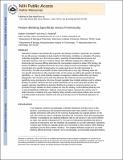Protein binding specificity versus promiscuity
Author(s)
Schreiber, Gideon; Keating, Amy E.
DownloadKeating_Protein binding.pdf (295.3Kb)
PUBLISHER_CC
Publisher with Creative Commons License
Creative Commons Attribution
Terms of use
Metadata
Show full item recordAbstract
Interactions between macromolecules in general, and between proteins in particular, are essential for any life process. Examples include transfer of information, inhibition or activation of function, molecular recognition as in the immune system, assembly of macromolecular structures and molecular machines, and more. Proteins interact with affinities ranging from millimolar to femtomolar and, because affinity determines the concentration required to obtain 50% binding, the amount of different complexes formed is very much related to local concentrations. Although the concentration of a specific binding partner is usually quite low in the cell (nanomolar to micromolar), the total concentration of other macromolecules is very high, allowing weak and non-specific interactions to play important roles. In this review we address the question of binding specificity, that is, how do some proteins maintain monogamous relations while others are clearly polygamous. We examine recent work that addresses the molecular and structural basis for specificity versus promiscuity. We show through examples how multiple solutions exist to achieve binding via similar interfaces and how protein specificity can be tuned using both positive and negative selection (specificity by demand). Binding of a protein to numerous partners can be promoted through variation in which residues are used for binding, conformational plasticity and/or post-translational modification. Natively unstructured regions represent the extreme case in which structure is obtained only upon binding. Many natively unstructured proteins serve as hubs in protein–protein interaction networks and such promiscuity can be of functional importance in biology.
Date issued
2010-11Department
Massachusetts Institute of Technology. Department of BiologyJournal
Current Opinion in Structural Biology
Publisher
Elsevier
Citation
Schreiber, Gideon, and Amy E Keating. “Protein Binding Specificity Versus Promiscuity.” Current Opinion in Structural Biology 21, no. 1 (February 2011): 50–61.
Version: Author's final manuscript
ISSN
0959440X